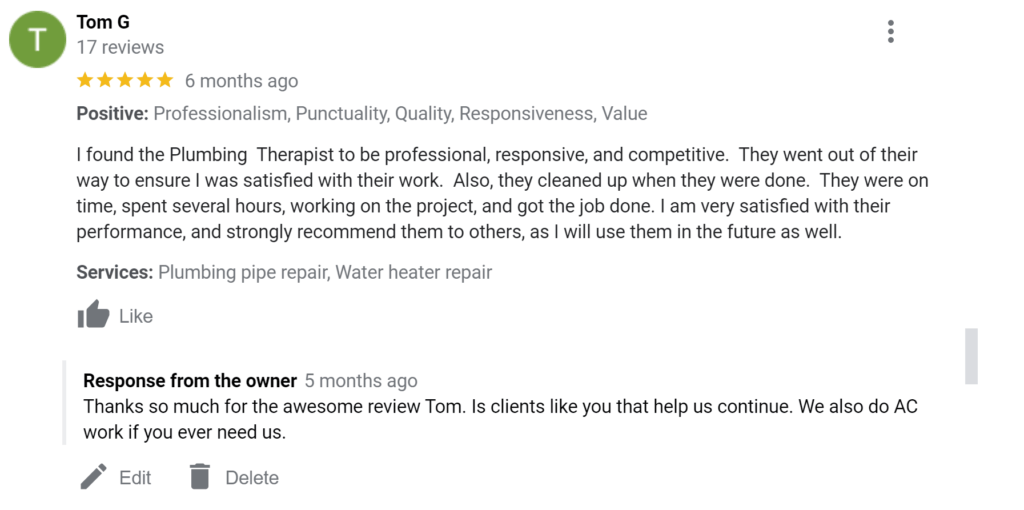Garbage Disposal Installation
At Plumbing Therapist, our certified technicians provide quick and reliable garbage disposal installation, enhancing kitchen efficiency and your peace of mind.
Do You Need Our Help ?
Feel free to contact us now
$99 Water Heater Flush + Free Plumbing System Inspection
Garbage Disposal Installation in Tampa Bay
Make Your Kitchen More Efficient with Professional Garbage Disposal Installation Services in Hillsborough County, Pinellas County, and Pasco County
Why Choose Plumbing Therapist for Garbage Disposal Installation?
Certified Technicians
Our team of certified technicians are trained to install all makes and models of garbage disposals, ensuring a smooth and reliable operation.
Quick Service
We understand your time is valuable. Our experts aim to complete each installation efficiently, letting you get back to your daily routine as quickly as possible.
Customer Satisfaction
Your satisfaction is our priority. We won’t consider the job done until you are fully satisfied with our service.
The Installation Process
- Consultation: We start by assessing your current plumbing setup and kitchen needs.
- Recommendation: Our experts recommend the best garbage disposal unit that fits your requirements.
- Installation: We perform a quick and hassle-free installation, adhering to all safety standards.
- Testing: Before we leave, we test the unit to make sure it’s operating correctly.
- Final Walk-through: We ensure you are satisfied and understand how to operate your new disposal unit.
Contact Us Today for a Free Estimate
Ready to make your kitchen more efficient? Contact us today or fill out our online form for a free estimate.

Why partner with Plumbing Therapist?
Quality, Affordability, and Expertise.

No Hidden or Unexpected Charges

Free Estimates & Online Booking Available

Professionally Trained Technicians

Honesty is Guaranteed

Quick Communication & Service Within 24 Hours

400+ 5 Star Reviews

Why do I need to have a garbage disposal at home?
Having a garbage disposal at home offers several benefits that can make your life easier and more convenient. Here are some reasons why you might want to consider installing one:
Efficiency and Convenience
Garbage disposals make it easy to get rid of food scraps, reducing the amount of waste that ends up in your trash can and ultimately the landfill. This is especially useful for those who cook frequently and generate a lot of kitchen waste.
Improved Sanitation
By grinding up food waste, garbage disposals help reduce the number of bacteria and foul odors in your kitchen. This can result in a cleaner and more hygienic home environment.
Reduced Plumbing Issues
Garbage disposals can help prevent clogs in your kitchen sink by breaking down food waste into smaller, more easily flushable pieces. However, it’s crucial to use the disposal properly to avoid putting substances like fats, oils, and fibrous foods down the drain, as they can still cause blockages.
Eco-friendly
Using a garbage disposal can be more environmentally friendly than throwing food waste in the trash. When food waste ends up in landfills, it decomposes anaerobically, producing methane—a potent greenhouse gas. In contrast, waste processed by a garbage disposal can be treated more efficiently at wastewater treatment facilities.
Saves Time and Effort
Having a garbage disposal eliminates the need to scrape every last bit of food off your plates before washing them, saving you time and effort during clean-up.
Adds Value to Your Home
A garbage disposal is an attractive feature for potential homebuyers, and having one installed could increase the value of your home.
Compatibility with Modern Lifestyles
For those who live in smaller homes or apartments where kitchen space is limited, garbage disposals offer a practical waste management solution without requiring additional room for composting or trash storage.
While garbage disposals offer numerous advantages, it’s essential to use and maintain them properly to maximize their benefits. Regular cleaning and avoiding putting certain types of waste down the disposal can ensure that it serves you well for years to come.
If you would like more information, feel free to give them a call at (813)-437-4477 or you can book online and get their latest discount!
Customer Testimonials: Real Experiences with Plumbing Therapist
We proudly share the experiences and stories of our valued clients. Their feedback provides a glimpse into the quality of service and commitment to excellence we uphold at Plumbing Therapist. You'll read firsthand how our plumbing solutions have improved comfort and efficiency in homes across Tampa Bay. These testimonials illustrate our dedication to customer satisfaction and the difference our expert services can make.




Your questions answered
Common Garbage Disposal Installation Questions:
What are the advantages and disadvantages of a garbage disposal?
Garbage disposals have their pros and cons, which should be considered before deciding to install one. Here are some of the advantages and disadvantages:
Advantages:
Efficiency and Convenience: Garbage disposals make it easier to manage kitchen waste, streamlining the cleaning process and reducing the need to handle food scraps manually.
Improved Sanitation: By grinding up food waste, garbage disposals can help reduce foul odors and bacteria growth in your kitchen.
Environmental Benefits: Disposals can reduce the amount of organic waste going to landfills, where it would decompose and produce methane, a potent greenhouse gas.
Reduced Plumbing Issues: When used correctly, a garbage disposal can help prevent sink clogs by breaking down food waste into smaller, more easily flushable pieces.
Saves Time: Using a garbage disposal can save you time during kitchen clean-up by quickly getting rid of food remnants.
Adds Value: Having a garbage disposal can add value to your home and is often seen as a desirable feature for prospective buyers.
Disadvantages:
Initial Cost: The upfront cost of purchasing and installing a garbage disposal can be relatively high, depending on the model and installation fees.
Maintenance Requirements: Garbage disposals require regular cleaning and can develop unpleasant odors if not properly maintained.
Noise: Most garbage disposals produce some level of noise during operation, which some people find bothersome.
Clog Risk: Improper use, such as disposing of grease, oil, or fibrous foods like celery, can lead to clogs either in the disposal unit itself or further down the plumbing system.
Power Consumption: While not hugely energy-intensive, garbage disposals do consume electricity, adding to your household energy bills.
Not Suitable for All Waste: Certain types of food waste, like bones or fruit pits, can damage the blades or motor and should not be put into the disposal.
Potential for Accidents: Because they contain rapidly spinning blades, there is a risk of injury if hands or utensils are accidentally inserted into the disposal.
Not Always Septic-Friendly: If your home relies on a septic system, you’ll need to be extra cautious about what you put down the disposal, and frequent use can lead to quicker filling of the septic tank.
Understanding these pros and cons can help you decide whether a garbage disposal is the right choice for your home and how to use it most effectively if you do opt to install one.
How does a garbage disposal work?
A garbage disposal is a kitchen appliance installed under the sink that grinds up food waste so it can be easily washed away through the plumbing system. Here’s a brief overview of how it works:
Components:
- Grinding Chamber: The core component where food waste is ground up.
- Impellers: Also known as “lugs,” these are metal or hard rubber pieces attached to the spinning plate.
- Spinning Plate: Rotates to help push food waste against the grind ring.
- Grind Ring: A shredding element against which the impellers push food to be ground.
- Electric Motor: Powers the spinning plate.
- Drain: Where the ground waste exits into the plumbing system.
- Sink Flange: Connects the garbage disposal to the sink.
- Hopper: The funnel-like part where food waste is initially placed.
Operation:
Start by Running Water: Before turning on the garbage disposal, it’s a good idea to let cold water run from the tap. This aids in the grinding process and helps transport waste through the pipes.
Turn On the Unit: A switch, often located on the wall or under the sink, is used to activate the garbage disposal. This starts the motor, causing the spinning plate to rotate.
Feed in the Waste: Food scraps are fed into the garbage disposal via the sink’s drain hole. The running water helps move the food into the grinding chamber.
Grinding Process: The rotating impellers fling the food particles against the grind ring, breaking them down into smaller pieces. The action is more of a grinding or shredding process rather than cutting, as there are no blades in most household garbage disposals.
Waste Disposal: The ground-up food waste is mixed with water to create a slurry, which is then flushed down the drain and into the sewage system or septic tank.
Turn Off the Unit and Water: Once the waste has been adequately ground and flushed away, you can turn off the garbage disposal followed by the water.
Safety Features:
Overload Protector: Most garbage disposals come with an overload protector that shuts off the unit if it becomes overheated or jammed, requiring manual resetting.
Manual Reset Button: If the unit does get jammed or overloaded, you can usually manually reset it using a button located at the bottom of the unit.
Batch-Feed Cover: Some garbage disposals require a cover to be in place for operation, adding an extra layer of safety.
It’s essential to be cautious and follow all safety guidelines when operating a garbage disposal to prevent accidental injury or damage to the unit.
What types of garbage disposals exist?
There are primarily two types of garbage disposals commonly found in residential settings: continuous-feed and batch-feed. Each has its own set of features, advantages, and disadvantages.
Continuous-Feed Garbage Disposals
Features:
- Operate continuously as long as the power switch is on
- Most commonly used type of garbage disposal
- Generally less expensive than batch-feed models
Advantages:
- Convenient for disposing of large quantities of food waste
- Allows for multitasking; you can keep adding waste while the unit is running
- Usually easier and less time-consuming to use
Disadvantages:
- Safety risk: Since it operates openly, there’s a potential for foreign objects (like utensils) or even hands to accidentally slip into the disposal
- Typically requires a wall switch or air switch for operation, which may necessitate additional installation
Batch-Feed Garbage Disposals
Features:
- Requires a stopper lid to be in place to activate the unit
- Operates in batches, meaning you load the waste, place the lid, and then turn on the unit
- Generally more expensive than continuous-feed models
Advantages:
- Safer to use, as it won’t operate unless the lid is in place, reducing the risk of accidents
- Ideal for homes with children or for people who are concerned about safety
- Doesn’t require a separate wall switch for operation
Disadvantages:
- Less convenient for large amounts of waste, as you have to load, cover, and grind in batches
- Usually more expensive than continuous-feed models
Other Variants:
Septic-Assist Garbage Disposals: Designed for homes with septic systems, these disposals inject bio-charge enzymes to help break down food waste, making it more septic-friendly.
Compact Models: Ideal for small households or places with limited under-sink space, these disposals have a smaller grinding chamber and less powerful motor.
High-Horsepower Models: More suited for large households or commercial settings, these disposals have a more powerful motor and larger grinding chambers to handle greater volumes of waste.
Quiet Models: Engineered to produce less noise, these are ideal for those who find the sound of garbage disposals bothersome.
When choosing a garbage disposal, consider factors such as your household size, safety preferences, available space, and whether or not you have a septic system.
Can I install a garbage disposal myself?
Installing a garbage disposal yourself is possible if you have a good understanding of plumbing and electrical work, as well as the necessary tools. However, if you’re not confident in your abilities or if you run into complications, it’s recommended to hire a professional to ensure the job is done correctly and safely.
Tools and Materials Needed:
- Adjustable wrench
- Plumber’s putty
- Screwdriver
- Plunger
- Bucket
- Pipe wrench
- Electrical cord and plug (if not pre-installed)
- Wire connectors
- Teflon tape
- Hacksaw (if you need to modify any plumbing)
General Steps for DIY Installation:
Safety First: Turn off the electrical circuit that will power the garbage disposal.
Remove the Old Unit: If you are replacing an old garbage disposal, you’ll need to disconnect it first. This involves unplugging it, disconnecting it from the plumbing, and unscrewing it from the mounting assembly.
Prepare the Sink: Clean the sink opening and apply a rope of plumber’s putty around it.
Install the Flange: Position the sink flange in the sink hole and press it down firmly. Secure it from below with a mounting ring and screws.
Attach the Disposal: Connect the garbage disposal unit to the mounting ring, making sure it’s securely in place.
Electrical Connections: If your unit doesn’t come pre-wired, you’ll need to connect it to an electrical cord and plug. Always follow the manufacturer’s instructions for wiring.
Connect the Drain: Attach the discharge tube to the disposal unit and then connect it to the sink drain. You might need to use a p-trap or other fittings to align everything correctly.
Check for Leaks: Before you tighten all connections, do a leak test by running water through the system.
Final Tightening: Once you’re sure there are no leaks, tighten all connections.
Power On: Restore power to the circuit, turn on the water, and test the unit to ensure it’s operating correctly.
Considerations:
Check Local Regulations: Some areas require a licensed professional to perform plumbing or electrical work, so make sure to check local building codes.
Warranty: Doing the installation yourself may void the manufacturer’s warranty, depending on its terms.
Safety: Make sure to follow all safety guidelines, especially for electrical connections, to minimize the risk of electric shock or other injuries.
If you encounter difficulties at any stage, it may be best to consult a professional to complete the installation.
What can and can't go into the garbage disposal?
Using a garbage disposal properly involves knowing what can and cannot be safely and effectively processed. Here’s a general guideline:
What Can Go In:
Soft Food Scraps: Small pieces of fruit, vegetables, and other soft foods are typically safe for the disposal.
Small Meat Scraps: While large bones are a no-go, small pieces of cooked meat can generally be processed.
Citrus Rinds: Small pieces can freshen up your disposal but should be used sparingly.
Coffee Grounds: In small amounts, they can clean your disposal but can cause clogs if used excessively.
Egg Shells: Some believe that egg shells can help sharpen the blades; however, they should be fed into the disposal gradually and with plenty of water.
Cooked Pasta and Rice: Small quantities are usually fine, but be cautious as they expand with water and could cause clogs over time.
Ice Cubes: These can actually help clean and sharpen the blades of your disposal.
What Can’t Go In:
Grease and Oil: These substances can solidify and clog the pipes.
Large Bones: Chicken and steak bones can break the disposal’s blades or motor.
Fibrous Vegetables: Items like celery, corn husks, and asparagus can entangle the blades.
Potato Peels: The starches can create a sticky mess and clog the disposal.
Glass, Plastic, Metal: Non-food items can severely damage the disposal unit.
Chemicals: Drain cleaners and other chemicals can damage the disposal and are harmful to the environment.
Coffee Grounds: While small amounts are fine, large quantities can accumulate and cause clogs.
Expandable Foods: Foods like pasta and rice expand when they come into contact with water, which could lead to clogs.
Nuts: These can turn into a paste-like substance (think peanut butter), causing clogs.
Fruit Pits and Seeds: These are too hard for the disposal to process and can cause damage.
Shellfish Shells: These are typically too tough for most residential garbage disposals.
Tips for Using Your Garbage Disposal:
Always run cold water before, during, and after using the disposal to help flush the waste through the pipes.
Don’t overload the disposal. Put waste in a little at a time.
Regularly clean the unit to prevent odor and bacteria buildup.
Misusing your garbage disposal can result in clogs, bad odors, or even damage to the unit itself. When in doubt, it’s better to dispose of questionable items in your regular trash or compost bin.

